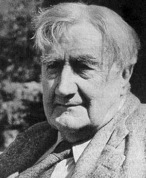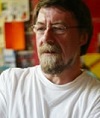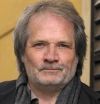At the Proms–Vaughan Williams, Osborne, and Eötvös
 One of the threads of this year’s Proms is a survey of the works of Ralph Vaughan Williams in commemoration of the fiftieth anniversary of his death. On August 26, which was the actual date of his death, the survey climaxed with an all-Vaughan Williams concert by the BBC Symphony, conducted by Sir Andrew Davis. The first work on the concert, the justly celebrated Fantasia on a Theme of Thomas Tallis; its performance, although maybe not exactly peremptory, was certainly restrained and cool, rather than as impassioned as one might have wished it to be. It was followed by the ballet score Job, with whose performance one could not argue. My own feeling about Job is that even though there is much very beautiful music in it, it is a little looser in construction and maybe a little more general in expression that the tightly constructed and closely argued symphonies, and that this is a, for lack of a better word, weakness in the piece.
One of the threads of this year’s Proms is a survey of the works of Ralph Vaughan Williams in commemoration of the fiftieth anniversary of his death. On August 26, which was the actual date of his death, the survey climaxed with an all-Vaughan Williams concert by the BBC Symphony, conducted by Sir Andrew Davis. The first work on the concert, the justly celebrated Fantasia on a Theme of Thomas Tallis; its performance, although maybe not exactly peremptory, was certainly restrained and cool, rather than as impassioned as one might have wished it to be. It was followed by the ballet score Job, with whose performance one could not argue. My own feeling about Job is that even though there is much very beautiful music in it, it is a little looser in construction and maybe a little more general in expression that the tightly constructed and closely argued symphonies, and that this is a, for lack of a better word, weakness in the piece.
The second half of the concert consisted of Serenade to Music, a short work setting an excerpt from The Merchant of Venice written to celebrate the fiftieth anniversary of the conducting career of Henry Wood, the founder of the Proms, and the Ninth Symphony. Serenade to Music was performed, as it was originally intended, by sixteen singers. It seems to me to be a just about perfect piece, and the performance was beautiful. The Ninth Symphony is a remarkable work. It holds a place in Vaughan Williams output somewhat analogous to that of the Requiem Canticles in Stravinsky’s; procedures and material from all earlier periods of his career appear, but both refined and, due to their different contexts, transformed into something new but with enormous added depth and expressive resonance. Each of the movements is the product of an extraordinarily original concept. In the first sonata form movement, a tune played by the clarinet accompanied by the harp, followed by a short trio for the clarinets, introduces the second theme; at the beginning of the recapitulation the clarinet tune returns played by the violin, leading directly to the second theme with a descant added on the flugel horn. From that point the events of the recapitulation proceeds in reverse order to that of the exposition, ending with the music for three saxophones that began the movement. In the second movement a solo line is alternated with a sort of court march which causes the line to fray and proliferate parts, leading to lyrical music for the full orchestra. The third movement is almost a mini-concerto for the saxophones, starting with perky soloistic lines accompanied by the snare drum and other percussion; that music develops into a fugue which is followed by a chorale that accelerates into very lively cascading music in close harmony that could have come from Duke Ellington and then dissolves, leaving only the ghosts of the accompaniment on the snare drum. The last movement is a complex two part form which begins quietly and contrapuntally and become a passacaglia somewhat like the last movement of the Fifth Symphony, but with more intensity. The whole work has a quality of intense urgency.
The most striking thing about the piece, though, may be its orchestration. It is interesting to compare it to that of Serenade to Music, whose harmony is full, rich, and warm, and whose orchestration is completely transparent. Vaughan Williams said that when he studied with Ravel, the French composer showed him how to orchestrate in points of color, and somehow that seems to be the idea in the vocal piece. In the Ninth Symphony, however, Vaughan Williams seems to have done something different: he was an organ player, and the orchestration in that piece seems to work more like organ registration, where volume and tone color are a function of doubling a line with more stops. The orchestration here is very thick, but not at all heavy or cluttered; in fact, it has a uniquely peculiar luminosity, which is animated by its actually relatively thin, more truly contrapuntal texture. In his program notes, Calum MacDonald describes the beginning as being like “a great fog-bank of tutti writing, at once solid and insubstantial.” The sound of the piece is also strongly colored by the inclusion of the three saxophones and flugel horn. The whole of the Ninth Symphony has a quality of intense urgency, and the wonderful performance seemed appropriately super charged.
An earlier installment of the survey of Vaughan Williams’s music was offered on August 17 by Lawrence Power with the City of London Sinfonia and the BBC Singers, conducted by Richard Hickox, with their performance of Flos Campi. The Latin title of the piece, which is essentially a viola concerto with the unusual accompaniment of small orchestra and wordless chorus, means “Lily of the Fields,” (I think that the King James Bible translates it as ‘Lily of the Valley;’ the members of the orchestra who did the first performance of the work began to call it Camp Flossie.) and each of its six movements is headed with a quotation from the Songs of Solomon, which is also the source of the title. Flos Campi contains exotically ecstatic music, starting predominantly polytonally and gradually evolving into quietly gentle music in D major and then back again at the end. The piece is quite lovely and it received a performance that was fervent and vivid.
 The same concert which had Flos Campi on it also contained a performance of Nigel Osborne’s Flute Concerto, which was written in 1980 for the City of London Sinfonia. It is a sixteen minute work in three movements for small orchestra (pairs of oboes and horns with strings), which is clearly intended as neo-classic piece, but features textures resembling the music of Lutoslawski, and is, in the slow movement, microtonal.
The same concert which had Flos Campi on it also contained a performance of Nigel Osborne’s Flute Concerto, which was written in 1980 for the City of London Sinfonia. It is a sixteen minute work in three movements for small orchestra (pairs of oboes and horns with strings), which is clearly intended as neo-classic piece, but features textures resembling the music of Lutoslawski, and is, in the slow movement, microtonal.
On August 27, the Vaughan Williams survey continued with a performance by Akiko Suwanai and the Philharmonia Orchestra, conducted by Susanna Mälkki (substituting for an unwell Peter Eötvös, who was the scheduled conductor), of The Lark Ascending for violin and orchestra. The Lark Ascending is, at least on the surface of it, a simple and effective piece. Apparently it is always in the top ten of most popular pieces in surveys taken by Classic FM, the commercial classical radio in Britain, but it’s not just an easy listening piece. Its construction and its material are economical and concise, its orchestration is effective, and its writing for the violin is beautiful. It shares with the Tallis Fantasia a tonal language which is a fusion of the practices of English Renaissance music and English folksong modality. The performance, which was a little on the slow and heavy side, unfortunately tended towards easy listening.
 This concert also included Eötvös’s violin concerto, entitled Seven–Memorial for the Columbia Astronauts. It commemorates the 2003 shuttle disaster, which caused the death of the seven members of its crew. The number seven is an important organizational factor: there are seven violins in the work and seven brass players and seven percussionists who play, altogether, 49 instruments; there are fourteen lower strings; moreover these instruments are deployed in seven groups. The Berg concerto, which is also a memorial work, is a model for Eötvös. Like the Berg, this work is cast in two big movements, the first of which memorialize and enshrine the personalities of the astronauts– in very literal and specific ways: there are seven sections, each on a portrait of one of the victims, including using intertwined themes from Israeli and Indian music to represent the Indian and Israeli members of the crew. The second movement is a dramatic three part form, ending with a duet between the soloist and an alto flute and featuring very high Bs, apparently representing the heights of space. The six other violinists, other than the soloists, are deployed around the audience, so it is surrounded by the discourse of the piece.
This concert also included Eötvös’s violin concerto, entitled Seven–Memorial for the Columbia Astronauts. It commemorates the 2003 shuttle disaster, which caused the death of the seven members of its crew. The number seven is an important organizational factor: there are seven violins in the work and seven brass players and seven percussionists who play, altogether, 49 instruments; there are fourteen lower strings; moreover these instruments are deployed in seven groups. The Berg concerto, which is also a memorial work, is a model for Eötvös. Like the Berg, this work is cast in two big movements, the first of which memorialize and enshrine the personalities of the astronauts– in very literal and specific ways: there are seven sections, each on a portrait of one of the victims, including using intertwined themes from Israeli and Indian music to represent the Indian and Israeli members of the crew. The second movement is a dramatic three part form, ending with a duet between the soloist and an alto flute and featuring very high Bs, apparently representing the heights of space. The six other violinists, other than the soloists, are deployed around the audience, so it is surrounded by the discourse of the piece.
The sound of the piece is handsome and the dramatic quality of it is impressive. The performance, despite the absence of the composer, who was originally supposed to conduct it, was assured and effective.
All of the Proms concerts are streamed as they happen, and are also available on the Proms website (http://www.bbc.co.uk/proms/2008/) for a week after the concert. The concerts are also rebroadcast a few days later, and those rebroadcasts are also available for a week, so there are ample opportunities to listen to them. There are also a number of complementary Vaughan Williams features available, including recordings of Vaughan Williams himself in talks he did for the BBC.